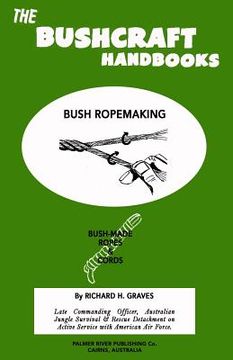Reseña del libro "The Bushcraft Handbooks - Bush Ropemaking (en Inglés)"
"The Bushcraft Handbooks" were first published in Australia in 1952. Based on the Author's wartime service in Australia and New Guinea teaching "Junglecraft" to Australian and American forces, they are distilled, concentrated old-time bushcraft knowledge, presented in a very easy to assimilate format. For those who remember them, the Bushcraft Handbooks are also a heavy hit of nostalgia. Rather than publish all of the volumes under the one cover, the Author originally chose to publish each aspect of bushcraft in its own individual handbook. His rationale was that the reader was more inclined to take a 50 page handbook with him into the wilds than a 400 page book. The former can be easily slipped into a pocket or daypack, while the latter cannot. The Bushcraft Handbooks are useless unless the reader practices the skills the books were designed to impart. The individual handbooks format was chosen to support that end. Out of print for decades, and in keeping with the Author's wishes, this series of Bushcraft Handbooks are reproduced as close to their original format as possible. The series comprises the following volumes: Bush Ropemaking, Bush Hutmaking, Traps & Snares, Bush Campcraft, Time & Direction, Travel & Gear, Food & Water in the Bush, Firemaking & Lighting, Trapping & Tracks, Knots & Lashings. From the introduction to "The Bushcraft Handbooks" were first published in Australia in 1952. Based on the Author's wartime service in Australia and New Guinea teaching "Junglecraft" to Australian and American forces, they are distilled, concentrated old-time bushcraft knowledge, presented in a very easy to assimilate format. For those who remember them, the Bushcraft Handbooks are also a heavy hit of nostalgia. Rather than publish all of the volumes under the one cover, the Author originally chose to publish each aspect of bushcraft in its own individual handbook. His rationale was that the reader was more inclined to take a 50 page handbook with him into the wilds than a 400 page book. The former can be easily slipped into a pocket or daypack, while the latter cannot. The Bushcraft Handbooks are useless unless the reader practices the skills the books were designed to impart. The individual handbooks format was chosen to support that end. Out of print for decades, and in keeping with the Author's wishes, this series of Bushcraft Handbooks are reproduced as close to their original format as possible. The series comprises the following volumes: Bush Ropemaking, Bush Hutmaking, Traps & Snares, Bush Campcraft, Time & Direction, Travel & Gear, Food & Water in the Bush, Firemaking & Lighting, Trapping & Tracks, Knots & Lashings. From the introduction to ""Bush Ropemaking" "One of the first needs in Bushcraft is the ability to join poles or sticks. The only method available is by the use of lashings. To use lashings however, it is necessary to have, find or make, materials for this purpose. The ability to spin, or plait fibres into ropes or cords is one of the oldest of man's primitive skills. The method is simple, and follows precisely the same stages that are made use of by today's complicated machines. The material from which to spin or plait ropes or cords is in abundance everywhere. Any fibrous material which has reasonable length, moderate strength and is flexible or pliable can be used. These are the three things to look for, and they can be found in many vines, grasses, barks, palms, and even in the hair of animals."

